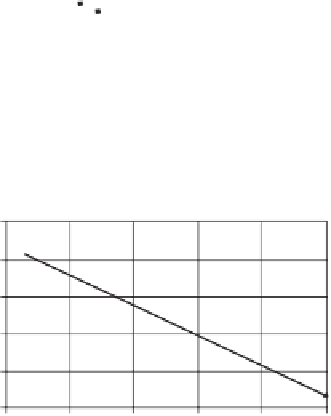Environmental Engineering Reference
In-Depth Information
The long-term matric suction changes in a slope are con-
trolled by factors related to the ground surface moisture flux
as well as the hydraulic properties of the soils near the
ground surface. The ratio of the ground surface moisture
flux to the saturated coefficient of permeability of the soil
near the ground surface appears to be the primary variable
that should be considered when assessing the permanence
of matric suction.
It is important to use design features that tend to reduce
the infiltration flux at ground surface. A common practice
in Hong Kong is to provide a layer of soil cement and
lime plaster cover called “chunam” on the soil slopes. Any
near-ground-surface layer of reduced permeability assists in
maintaining the matric suction in the underlying soils. Lim
et al. (1996) carried out a field instrumentation program to
monitor negative pore-water pressures in residual soil slopes
in Singapore. The slopes were protected by various types of
surface covers. Changes in matric suction due to changes
in ground surface moisture flux were found to be most sig-
nificant below a bare slope and least significant under a
canvas-covered slope. Other relatively impermeable surface
covers can also be adopted depending on the saturated coef-
ficients of permeability of the material at the surface of a
slope.
It is also effective to maintain negative pore pressures in
a slope through the use of a soil of reduced saturated perme-
ability (see Fig. 8.91). After the 1976 Sau Mau Ping failure
in Hong Kong, the investigation panel (Government of Hong
Kong, 1976) recommended that the minimum stabilization
of a suspect slope should consist of removing the loose sur-
face soil by excavating the slope to a vertical depth of not
less than 3 m for slopes that were not steeper than 1 on 1.5
and recompacting the soil to 95% of standard compaction
density. The average saturated coefficient of permeability
for the Sau Mau Ping earthfill material decreased by three
times when the relative compaction of the fill was increased
from 82 to 95%.
In some cases it might not be practical to prevent the
infiltration of rainfall into a soil slope through use of a rela-
tively impermeable surface cover. It still may not mean that
the matric suctions will go toward zero with time. Steady-
state simulations might reveal a permanence of the negative
pore-water pressure conditions. On the other hand, it may
be important to assume zero matric suction in the slope
for design purposes when the results of numerical modeling
simulations considering realistic site and weather conditions
show that negative pore-water pressures cannot be main-
tained. The risks associated with a possible slope failure
also need to be taken into consideration.
The initial pore-water pressure conditions in the slope and
the boundary conditions of the slope are important factors
to be considered in the quantification of possible changes
in pore-water pressures. Numerical studies provide an
75
Initial
1 day
2 days
4 days
6 days
9 days
12 days
70
65
60
a
f
= 10,
n
f
= 2,
m
f
= 1
q
= 10
−
6
m/s
k
sat
= 10
−
5
m/s
55
50
−
160
−
120
−
80
−
40
0
40
Pore-water pressure (kPa)
(a)
75
70
Initial
2 h
8 h
24 h
2 days
4 days
65
60
a
f
= 100,
n
f
= 2,
m
f
= 1
q
= 10
−
6
m/s
k
sat
= 10
−
5
m/s
55
50
−
160
−
120
−
80
−
40
0
40
Pore-water pressure (kPa)
(b)
Figure 8.91
Pore-water pressure profiles in a slope (with a water
table) subjected to rainfall flux
q
10
−
6
m/s: (a)
a
f
=
=
10 kPa;
(b)
a
f
=
100 kPa (after Zhang et al., 2004).
the application of numerical modeling of rainfall infiltra-
tion has not significantly influenced engineering design. The
use of matric suction in slope design has not yet received
general acceptance in routine engineering practice. There
appears to be a perception that there are insufficient field
measurements as well as modeling studies to demonstrate
the long-term reliance upon matric suction in soil slopes dur-
ing and after rainstorms. The results of the above parametric
numerical study contribute to a better understanding of infil-
tration processes. The studies assist geotechnical engineers
in formulating more appropriate engineering design proto-
cols and practices where the permanence of matric suction
is part of the functionality of slopes.
Numerical studies allow for a wide variety of factors to
be considered during the design of a soil slope. Once the
SWCCs and the saturated coefficients of permeability for
the materials involved are known, the times required for the
dissipation of negative pore-water pressure under various
rainstorm conditions can be modeled. If the matric suction
requires more time to dissipate than the possible duration of
heavy rainfalls, then the matric suction profiles should be
taken into consideration in the design of the soil slope. On
the other hand, if the dissipation or loss of matric suctions
occurs in a relatively short time, the soil slope needs to be
designed accordingly.

































Search WWH ::

Custom Search